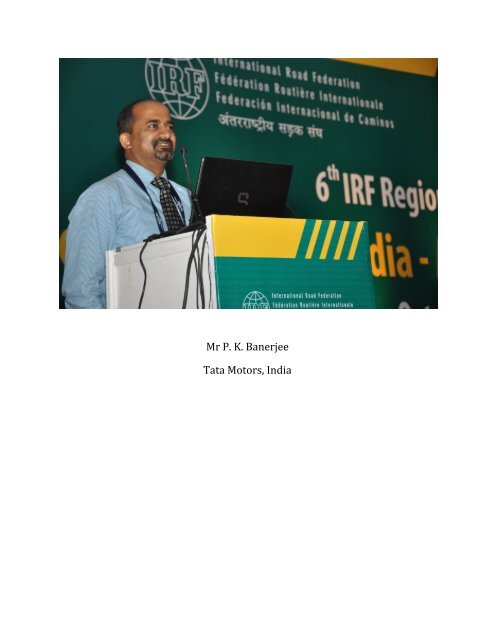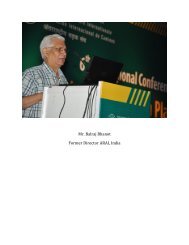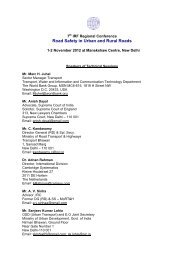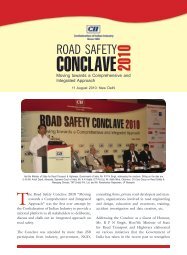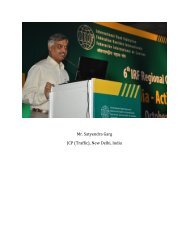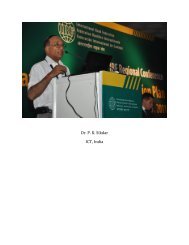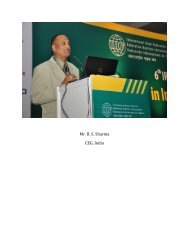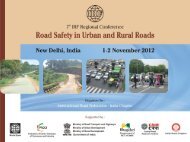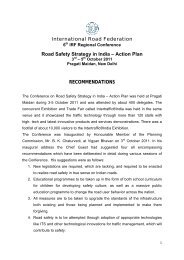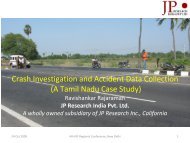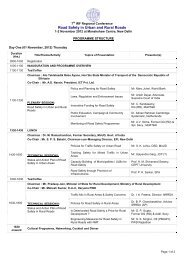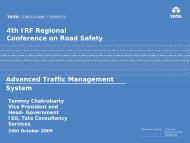Mr P. K. Banerjee Tata Motors, India - Road Safety in India|NGO on ...
Mr P. K. Banerjee Tata Motors, India - Road Safety in India|NGO on ...
Mr P. K. Banerjee Tata Motors, India - Road Safety in India|NGO on ...
You also want an ePaper? Increase the reach of your titles
YUMPU automatically turns print PDFs into web optimized ePapers that Google loves.
<str<strong>on</strong>g>Mr</str<strong>on</strong>g> P. K. <str<strong>on</strong>g>Banerjee</str<strong>on</strong>g><br />
<str<strong>on</strong>g>Tata</str<strong>on</strong>g> <str<strong>on</strong>g>Motors</str<strong>on</strong>g>, <str<strong>on</strong>g>India</str<strong>on</strong>g>
6 TH<br />
TH IRF REGIONAL CONFERENCE<br />
5 TH OCT 2011, NEW DELHI<br />
Advances <str<strong>on</strong>g>in</str<strong>on</strong>g> In-Vehicle <str<strong>on</strong>g>Safety</str<strong>on</strong>g> Devices<br />
Prashant Kumar <str<strong>on</strong>g>Banerjee</str<strong>on</strong>g><br />
Head (Homologati<strong>on</strong> & Product Evaluati<strong>on</strong>), ERC, TATA<str<strong>on</strong>g>Motors</str<strong>on</strong>g><br />
© Copyright <str<strong>on</strong>g>Tata</str<strong>on</strong>g> <str<strong>on</strong>g>Motors</str<strong>on</strong>g> Ltd.<br />
1
How Far In‐Vehicle <str<strong>on</strong>g>Safety</str<strong>on</strong>g> Norms Should Go <str<strong>on</strong>g>in</str<strong>on</strong>g> <str<strong>on</strong>g>India</str<strong>on</strong>g>???<br />
6<br />
7<br />
2<br />
1<br />
2<br />
7<br />
8<br />
6<br />
4<br />
1<br />
3<br />
3<br />
1<br />
Steer<str<strong>on</strong>g>in</str<strong>on</strong>g>g wheel c<strong>on</strong>form<str<strong>on</strong>g>in</str<strong>on</strong>g>g to impact tests<br />
(No Steer<str<strong>on</strong>g>in</str<strong>on</strong>g>g wheel, Only steer<str<strong>on</strong>g>in</str<strong>on</strong>g>g handle)<br />
2 Driver field of Visi<strong>on</strong> <br />
3 Two headlight for night driv<str<strong>on</strong>g>in</str<strong>on</strong>g>g (One headlamp) <br />
4 Doors for occupant safety (No doors) <br />
5 Bumper for Pedestrian safety (No bumper) <br />
6<br />
7<br />
Interior fitt<str<strong>on</strong>g>in</str<strong>on</strong>g>gs to avoid occupant <str<strong>on</strong>g>in</str<strong>on</strong>g>jury<br />
(Not c<strong>on</strong>trolled hence dangerous)<br />
Str<str<strong>on</strong>g>in</str<strong>on</strong>g>gent wip<str<strong>on</strong>g>in</str<strong>on</strong>g>g requirement for Wet driv<str<strong>on</strong>g>in</str<strong>on</strong>g>g<br />
(M<str<strong>on</strong>g>in</str<strong>on</strong>g>imum i requirements, Hand operated is OK)<br />
<br />
8 Seats & Seat belt c<strong>on</strong>form<str<strong>on</strong>g>in</str<strong>on</strong>g>g to anchorage test <br />
© Copyright <str<strong>on</strong>g>Tata</str<strong>on</strong>g> <str<strong>on</strong>g>Motors</str<strong>on</strong>g> Ltd.<br />
<br />
<br />
5<br />
1 Steer<str<strong>on</strong>g>in</str<strong>on</strong>g>g wheel c<strong>on</strong>form<str<strong>on</strong>g>in</str<strong>on</strong>g>g to impact tests <br />
2 Driver field of Visi<strong>on</strong> <br />
3<br />
Two headlight for night driv<str<strong>on</strong>g>in</str<strong>on</strong>g>g<br />
(Better road illum<str<strong>on</strong>g>in</str<strong>on</strong>g>ati<strong>on</strong>)<br />
4 Doors for occupant safety <br />
5 Bumper for Pedestrian safety <br />
6 Interior fitt<str<strong>on</strong>g>in</str<strong>on</strong>g>gs to avoid occupant <str<strong>on</strong>g>in</str<strong>on</strong>g>jury <br />
7 Str<str<strong>on</strong>g>in</str<strong>on</strong>g>gent wip<str<strong>on</strong>g>in</str<strong>on</strong>g>g requirement for Wet driv<str<strong>on</strong>g>in</str<strong>on</strong>g>g <br />
8 Seats & Seat belt c<strong>on</strong>form<str<strong>on</strong>g>in</str<strong>on</strong>g>g to anchorage test <br />
4<br />
2
C<strong>on</strong>tent<br />
t<br />
• Current Vehicle <str<strong>on</strong>g>Safety</str<strong>on</strong>g> C<strong>on</strong>cerns <str<strong>on</strong>g>in</str<strong>on</strong>g> <str<strong>on</strong>g>India</str<strong>on</strong>g><br />
• Near Term Vehicle <str<strong>on</strong>g>Safety</str<strong>on</strong>g> <str<strong>on</strong>g>Road</str<strong>on</strong>g> Map<br />
• L<strong>on</strong>g Term Advances <str<strong>on</strong>g>in</str<strong>on</strong>g> Vehicle <str<strong>on</strong>g>Safety</str<strong>on</strong>g><br />
• C<strong>on</strong>clusi<strong>on</strong><br />
© Copyright <str<strong>on</strong>g>Tata</str<strong>on</strong>g> <str<strong>on</strong>g>Motors</str<strong>on</strong>g> Ltd.<br />
3
Steps towards better safety<br />
European <str<strong>on</strong>g>Road</str<strong>on</strong>g> <str<strong>on</strong>g>Safety</str<strong>on</strong>g> 2011‐2020<br />
2020<br />
On 1 September 2011, the European Parliament’s Committee <strong>on</strong> Transport &<br />
Tourism published the c<strong>on</strong>solidated Koch report <strong>on</strong> “European <str<strong>on</strong>g>Road</str<strong>on</strong>g> <str<strong>on</strong>g>Safety</str<strong>on</strong>g> 2011‐<br />
2020”.<br />
The report endorses the objective of halv<str<strong>on</strong>g>in</str<strong>on</strong>g>g EU road deaths by 2020<br />
(<str<strong>on</strong>g>in</str<strong>on</strong>g> comparis<strong>on</strong> with 2010), and <str<strong>on</strong>g>in</str<strong>on</strong>g> additi<strong>on</strong> calls for:<br />
• 60% reducti<strong>on</strong> <str<strong>on</strong>g>in</str<strong>on</strong>g> the number of children under the age of 14 killed <str<strong>on</strong>g>in</str<strong>on</strong>g> road accidents<br />
• 50% reducti<strong>on</strong> <str<strong>on</strong>g>in</str<strong>on</strong>g> the number of pedestrians and cyclists kll killed <str<strong>on</strong>g>in</str<strong>on</strong>g> road collisi<strong>on</strong>s<br />
• 40% reducti<strong>on</strong> <str<strong>on</strong>g>in</str<strong>on</strong>g> the number of people suffer<str<strong>on</strong>g>in</str<strong>on</strong>g>g critical <str<strong>on</strong>g>in</str<strong>on</strong>g>juries<br />
The report also calls <strong>on</strong> to “put safer vehicles <strong>on</strong> the road” through the assessment,<br />
development and implementati<strong>on</strong> of a number of safety checks, <str<strong>on</strong>g>in</str<strong>on</strong>g>clud<str<strong>on</strong>g>in</str<strong>on</strong>g>g: alcolocks,<br />
crash management systems, seat‐belt rem<str<strong>on</strong>g>in</str<strong>on</strong>g>der systems, fatigue warn<str<strong>on</strong>g>in</str<strong>on</strong>g>g systems,<br />
<str<strong>on</strong>g>in</str<strong>on</strong>g>tegrated accident recorder systems, fr<strong>on</strong>t‐underrun protective devices, and <str<strong>on</strong>g>in</str<strong>on</strong>g>telligent<br />
speed assistance systems.<br />
© Copyright <str<strong>on</strong>g>Tata</str<strong>on</strong>g> <str<strong>on</strong>g>Motors</str<strong>on</strong>g> Ltd.<br />
4
C<strong>on</strong>spicuity Mark<str<strong>on</strong>g>in</str<strong>on</strong>g>g<br />
The human factors<br />
Night‐time visibility<br />
Just 5% of the <str<strong>on</strong>g>in</str<strong>on</strong>g>formati<strong>on</strong> we see<br />
<str<strong>on</strong>g>in</str<strong>on</strong>g> daylight are caught by the eye at<br />
night.<br />
Day<br />
Night<br />
Age Factor<br />
Every 13 years we need twice as<br />
much light to see as well as at the<br />
age of 20<br />
© Copyright <str<strong>on</strong>g>Tata</str<strong>on</strong>g> <str<strong>on</strong>g>Motors</str<strong>on</strong>g> Ltd.<br />
5
C<strong>on</strong>spicuity Mark<str<strong>on</strong>g>in</str<strong>on</strong>g>g<br />
Mandatory Requirements<br />
Colour & Width of Mark<str<strong>on</strong>g>in</str<strong>on</strong>g>g<br />
• Side – Yellow - 50mm width<br />
• Rear – Red - 50mm width<br />
Mandatory Requirements<br />
Rear ‐ RED Full c<strong>on</strong>tour mark<str<strong>on</strong>g>in</str<strong>on</strong>g>gs<br />
Vehicles exceed<str<strong>on</strong>g>in</str<strong>on</strong>g>g 2.1m width<br />
Side – Yellow Partial c<strong>on</strong>tour mark<str<strong>on</strong>g>in</str<strong>on</strong>g>gs<br />
Vehicles exceed<str<strong>on</strong>g>in</str<strong>on</strong>g>g 6000 mm length<br />
Applicable categories<br />
N2>7.5 t<strong>on</strong> category<br />
N3 Category<br />
T3 Category<br />
T4 Category<br />
Internati<strong>on</strong>al studies show that presence<br />
of reflective tapes result <str<strong>on</strong>g>in</str<strong>on</strong>g> :‐<br />
41% fewer rear end collisi<strong>on</strong>s<br />
37 % fewer side collisi<strong>on</strong>s<br />
© Copyright <str<strong>on</strong>g>Tata</str<strong>on</strong>g> <str<strong>on</strong>g>Motors</str<strong>on</strong>g> Ltd.<br />
6
Bus Transport Industry – Exist<str<strong>on</strong>g>in</str<strong>on</strong>g>g Scenario<br />
Unsafe practices observed<br />
Unsafe seat designs<br />
Poor c<strong>on</strong>diti<strong>on</strong> of bus<br />
Poor c<strong>on</strong>diti<strong>on</strong> of bus<br />
Unsafe driver’s worklplace<br />
No provisi<strong>on</strong>s for disabled<br />
Unsafe driver’s worklplace<br />
© Copyright <str<strong>on</strong>g>Tata</str<strong>on</strong>g> <str<strong>on</strong>g>Motors</str<strong>on</strong>g> Ltd.<br />
7
Vehicle C<strong>on</strong>structi<strong>on</strong><br />
AIS:052 - Code of practice for Bus Body Design & Approval<br />
<br />
<br />
Formulated with a view to br<str<strong>on</strong>g>in</str<strong>on</strong>g>g uniformity <str<strong>on</strong>g>in</str<strong>on</strong>g> the bus body build<str<strong>on</strong>g>in</str<strong>on</strong>g>g and to ensure<br />
m<str<strong>on</strong>g>in</str<strong>on</strong>g>imum acceptable level of passenger safety and comfort.<br />
Also, established a system of Accreditati<strong>on</strong> of Bus Body Builders <str<strong>on</strong>g>in</str<strong>on</strong>g> the country<br />
Follow<str<strong>on</strong>g>in</str<strong>on</strong>g>g critical areas addressed <str<strong>on</strong>g>in</str<strong>on</strong>g> the regulati<strong>on</strong> besides other general aspects -<br />
Various safety related features like entry / exit door , emergency exits, w<str<strong>on</strong>g>in</str<strong>on</strong>g>dow frames,<br />
their locati<strong>on</strong>s, dimensi<strong>on</strong>s and designs.<br />
Standardizati<strong>on</strong> of the gangways and dimensi<strong>on</strong>s of the foot steps.<br />
Dimensi<strong>on</strong> of seats, seat<str<strong>on</strong>g>in</str<strong>on</strong>g>g layout, light<str<strong>on</strong>g>in</str<strong>on</strong>g>g and illum<str<strong>on</strong>g>in</str<strong>on</strong>g>ati<strong>on</strong>.<br />
Driver’s workplace requirements.<br />
Provisi<strong>on</strong>s for the pers<strong>on</strong>s with disabilities.<br />
Stability and strength evaluati<strong>on</strong>s of the bus body structure, seat anchorages etc.,<br />
<str<strong>on</strong>g>in</str<strong>on</strong>g>clud<str<strong>on</strong>g>in</str<strong>on</strong>g>g the roll over test for the full body.<br />
Requirements related to light<str<strong>on</strong>g>in</str<strong>on</strong>g>g, illum<str<strong>on</strong>g>in</str<strong>on</strong>g>ati<strong>on</strong>, electrical equipment & wir<str<strong>on</strong>g>in</str<strong>on</strong>g>g<br />
All these requirements are followed by OEMs, but, majority of unorganized<br />
sector bus body builders do not follow, lead<str<strong>on</strong>g>in</str<strong>on</strong>g>g to comprise <str<strong>on</strong>g>in</str<strong>on</strong>g> vehicular safety.<br />
© Copyright <str<strong>on</strong>g>Tata</str<strong>on</strong>g> <str<strong>on</strong>g>Motors</str<strong>on</strong>g> Ltd.<br />
8
Vehicle C<strong>on</strong>structi<strong>on</strong><br />
AIS:031 - Strength of Superstructure of Large Passenger Vehicles<br />
(Type II & III Buses with more than 22 Passengers)<br />
The Strength of superstructure of the vehicle shall be<br />
verified accord<str<strong>on</strong>g>in</str<strong>on</strong>g>g to <strong>on</strong>e of the follow<str<strong>on</strong>g>in</str<strong>on</strong>g>g methods<br />
‐<br />
<br />
<br />
<br />
<br />
A roll‐over test <strong>on</strong> a complete vehicle<br />
A roll‐over test <strong>on</strong> a body secti<strong>on</strong> or<br />
secti<strong>on</strong>s representative of a complete<br />
vehicle<br />
A pendulum test <strong>on</strong> a body secti<strong>on</strong> or<br />
secti<strong>on</strong>s<br />
A verificati<strong>on</strong> of strength of superstructure<br />
by calculati<strong>on</strong><br />
© Copyright <str<strong>on</strong>g>Tata</str<strong>on</strong>g> <str<strong>on</strong>g>Motors</str<strong>on</strong>g> Ltd.<br />
A Roll-overover event is<br />
<strong>on</strong>e of the most<br />
crucial hazards for<br />
the safety of<br />
passengers and the<br />
crew rid<str<strong>on</strong>g>in</str<strong>on</strong>g>g <str<strong>on</strong>g>in</str<strong>on</strong>g> a bus.<br />
COLLAPSED ROOF STRUCTURE<br />
Roll Over requirements are CMVR notified & followed by OEMs. But, not by<br />
unorganized sector bus body builders, abig<br />
enforcement gap &safety<br />
c<strong>on</strong>cerns<br />
.<br />
9
Vehicle C<strong>on</strong>structi<strong>on</strong><br />
AIS:031 - Strength of Superstructure of Large Passenger Vehicles<br />
C<strong>on</strong>td…<br />
Residual Space Def<str<strong>on</strong>g>in</str<strong>on</strong>g>iti<strong>on</strong><br />
Residual Space<br />
F<str<strong>on</strong>g>in</str<strong>on</strong>g>ite Element Model<br />
© Copyright <str<strong>on</strong>g>Tata</str<strong>on</strong>g> <str<strong>on</strong>g>Motors</str<strong>on</strong>g> Ltd.<br />
10
Vehicle C<strong>on</strong>structi<strong>on</strong><br />
AIS:029 - Requirements of Survival Space for the Protecti<strong>on</strong> of the<br />
Occupants of the Cab of a Commercial Vehicle of N Category.<br />
The cab of the vehicle shall be so designed and so attached to the vehicle as to<br />
elim<str<strong>on</strong>g>in</str<strong>on</strong>g>ate to the greatest possible extent the risk of <str<strong>on</strong>g>in</str<strong>on</strong>g>jury to the occupants <str<strong>on</strong>g>in</str<strong>on</strong>g> the<br />
event of an accident.<br />
All these<br />
requirements<br />
are<br />
<strong>on</strong>ly<br />
followed by<br />
OEMs & not<br />
by<br />
unorganized<br />
sector<br />
Truck<br />
body<br />
builders, The enforcement need to<br />
be str<str<strong>on</strong>g>in</str<strong>on</strong>g>gent <str<strong>on</strong>g>in</str<strong>on</strong>g> view of safety.<br />
Fr<strong>on</strong>t impact by<br />
sw<str<strong>on</strong>g>in</str<strong>on</strong>g>g<str<strong>on</strong>g>in</str<strong>on</strong>g>g bob<br />
Manik<str<strong>on</strong>g>in</str<strong>on</strong>g> to verify the<br />
Survival Space<br />
© Copyright <str<strong>on</strong>g>Tata</str<strong>on</strong>g> <str<strong>on</strong>g>Motors</str<strong>on</strong>g> Ltd.<br />
Roof strength test<br />
Rear wall strength<br />
11
Vehicle C<strong>on</strong>structi<strong>on</strong><br />
Unauthorized c<strong>on</strong>structi<strong>on</strong>s & Unsafe vehicles<br />
Chakda<br />
Jugad<br />
Popular <str<strong>on</strong>g>in</str<strong>on</strong>g> Areas of Gujarat<br />
Popular <str<strong>on</strong>g>in</str<strong>on</strong>g> Areas of Punjab<br />
© Copyright <str<strong>on</strong>g>Tata</str<strong>on</strong>g> <str<strong>on</strong>g>Motors</str<strong>on</strong>g> Ltd.<br />
12
Adherence to Rules<br />
Over load<str<strong>on</strong>g>in</str<strong>on</strong>g>g a major safety issue<br />
Overload<str<strong>on</strong>g>in</str<strong>on</strong>g>g of Bus<br />
Overload<str<strong>on</strong>g>in</str<strong>on</strong>g>g of Truck<br />
Lack of Enforcement<br />
© Copyright <str<strong>on</strong>g>Tata</str<strong>on</strong>g> <str<strong>on</strong>g>Motors</str<strong>on</strong>g> Ltd.<br />
13
Adherence to Rules<br />
In-service Compliance<br />
Validity of Certificate of fitness for transport vehicles -<br />
• New transport vehicle : 2 years<br />
• Renewal of Certificate of fitness : 1 year<br />
Renewal of a fitness certificate shall be made <strong>on</strong>ly after<br />
the Inspect<str<strong>on</strong>g>in</str<strong>on</strong>g>g Officer or Authorized test<str<strong>on</strong>g>in</str<strong>on</strong>g>g stati<strong>on</strong>s has<br />
carried the tests as specified at CMVR Rule No. 62<br />
Strict Implementati<strong>on</strong> is needed<br />
© Copyright <str<strong>on</strong>g>Tata</str<strong>on</strong>g> <str<strong>on</strong>g>Motors</str<strong>on</strong>g> Ltd.<br />
14
How Relevant is Cost to <str<strong>on</strong>g>Safety</str<strong>on</strong>g> <str<strong>on</strong>g>in</str<strong>on</strong>g> <str<strong>on</strong>g>India</str<strong>on</strong>g>???<br />
Two wheeler are for Two<br />
<str<strong>on</strong>g>Safety</str<strong>on</strong>g> Features<br />
1 Steer<str<strong>on</strong>g>in</str<strong>on</strong>g>g wheel c<strong>on</strong>form<str<strong>on</strong>g>in</str<strong>on</strong>g>g to impact tests <br />
2 Driver field of Visi<strong>on</strong> <br />
3<br />
Two headlight for night driv<str<strong>on</strong>g>in</str<strong>on</strong>g>g<br />
(Better road illum<str<strong>on</strong>g>in</str<strong>on</strong>g>ati<strong>on</strong>)<br />
4 Doors for occupant safety <br />
5 Bumper for Pedestrian safety <br />
6 Interior fitt<str<strong>on</strong>g>in</str<strong>on</strong>g>gs to avoid occupant <str<strong>on</strong>g>in</str<strong>on</strong>g>jury <br />
7 Str<str<strong>on</strong>g>in</str<strong>on</strong>g>gent t wip<str<strong>on</strong>g>in</str<strong>on</strong>g>g i requirement for Wet driv<str<strong>on</strong>g>in</str<strong>on</strong>g>g i <br />
<br />
8 Seats & Seat belt c<strong>on</strong>form<str<strong>on</strong>g>in</str<strong>on</strong>g>g to anchorage test <br />
© Copyright <str<strong>on</strong>g>Tata</str<strong>on</strong>g> <str<strong>on</strong>g>Motors</str<strong>on</strong>g> Ltd.<br />
15
HARMONISATION WITH ECE STANDARDS<br />
Aligned EU Regulati<strong>on</strong>s<br />
EU<br />
<str<strong>on</strong>g>India</str<strong>on</strong>g><br />
Rema<str<strong>on</strong>g>in</str<strong>on</strong>g><str<strong>on</strong>g>in</str<strong>on</strong>g>g items:<br />
• EURO V<br />
• Replacement of Cat. C<strong>on</strong><br />
GRRF<br />
EU Specific<br />
Regulati<strong>on</strong>s<br />
<str<strong>on</strong>g>India</str<strong>on</strong>g> Unique<br />
Regulati<strong>on</strong>s<br />
CMVR = Aligned EU regulati<strong>on</strong>s + <str<strong>on</strong>g>India</str<strong>on</strong>g> Unique regulati<strong>on</strong>s<br />
© Copyright <str<strong>on</strong>g>Tata</str<strong>on</strong>g> <str<strong>on</strong>g>Motors</str<strong>on</strong>g> Ltd.<br />
16
© Copyright <str<strong>on</strong>g>Tata</str<strong>on</strong>g> <str<strong>on</strong>g>Motors</str<strong>on</strong>g> Ltd.<br />
17
<str<strong>on</strong>g>Safety</str<strong>on</strong>g><br />
In automotive terms, the safety is categorized basically <str<strong>on</strong>g>in</str<strong>on</strong>g> to two types.<br />
Passive <str<strong>on</strong>g>Safety</str<strong>on</strong>g><br />
Active <str<strong>on</strong>g>Safety</str<strong>on</strong>g><br />
ABS<br />
Adaptive<br />
Headlight<br />
Seat Belts<br />
Air Bags<br />
Collapsible<br />
Steer<str<strong>on</strong>g>in</str<strong>on</strong>g>g column<br />
ESC<br />
TPMS<br />
LDWS<br />
Facilitates the driver to avoid<br />
crash by means of the devices<br />
provided <str<strong>on</strong>g>in</str<strong>on</strong>g> the vehicle<br />
Protects the occupants <str<strong>on</strong>g>in</str<strong>on</strong>g> the<br />
.<br />
event of crash by means of the<br />
devices provided <str<strong>on</strong>g>in</str<strong>on</strong>g> the vehicle<br />
© Copyright <str<strong>on</strong>g>Tata</str<strong>on</strong>g> <str<strong>on</strong>g>Motors</str<strong>on</strong>g> Ltd.<br />
18
Upcom<str<strong>on</strong>g>in</str<strong>on</strong>g>g <str<strong>on</strong>g>Safety</str<strong>on</strong>g> Regulati<strong>on</strong>s<br />
Sr<br />
Regulati<strong>on</strong><br />
.<br />
Standard<br />
1 Interior Fitt<str<strong>on</strong>g>in</str<strong>on</strong>g>gs for other than M1 AIS:047<br />
Date of <str<strong>on</strong>g>in</str<strong>on</strong>g>troducti<strong>on</strong><br />
2012 (new)/<br />
2013 (Exist<str<strong>on</strong>g>in</str<strong>on</strong>g>g)<br />
2 Anti‐theft Devices AIS:075 To be notified<br />
3 Offset Fr<strong>on</strong>tal Collisi<strong>on</strong> AIS 098 To be notified<br />
4 Lateral Collisi<strong>on</strong> AIS 099 To be notified<br />
5 EMC AIS:004:Part 3 To be notified<br />
© Copyright <str<strong>on</strong>g>Tata</str<strong>on</strong>g> <str<strong>on</strong>g>Motors</str<strong>on</strong>g> Ltd.<br />
19
Upcom<str<strong>on</strong>g>in</str<strong>on</strong>g>g <str<strong>on</strong>g>Safety</str<strong>on</strong>g> Regulati<strong>on</strong>s<br />
AIS:047 – Interior Fitt<str<strong>on</strong>g>in</str<strong>on</strong>g>gs<br />
(Specificati<strong>on</strong>s for other than M1 Category Vehicles)<br />
<br />
In order to specify the requirements of <str<strong>on</strong>g>in</str<strong>on</strong>g>terior fitt<str<strong>on</strong>g>in</str<strong>on</strong>g>gs for vehicles other than M1<br />
category <str<strong>on</strong>g>in</str<strong>on</strong>g> order to ensure safety of the travel<str<strong>on</strong>g>in</str<strong>on</strong>g>g passengers<br />
Interior fitt<str<strong>on</strong>g>in</str<strong>on</strong>g>gs covers –<br />
• The <str<strong>on</strong>g>in</str<strong>on</strong>g>terior parts (other than rear view mirrors) which are c<strong>on</strong>tactable by the seated<br />
occupants <str<strong>on</strong>g>in</str<strong>on</strong>g> the fr<strong>on</strong>t (First) row of forward fac<str<strong>on</strong>g>in</str<strong>on</strong>g>g seats when likely to be impacted<br />
dur<str<strong>on</strong>g>in</str<strong>on</strong>g>g fr<strong>on</strong>tal impacts <strong>on</strong>ly.<br />
• The protrusi<strong>on</strong>s of c<strong>on</strong>trols.<br />
Requirements covered are for follow<str<strong>on</strong>g>in</str<strong>on</strong>g>g areas –<br />
• Forward Interior Parts above the Level of the Instrument Panel <str<strong>on</strong>g>in</str<strong>on</strong>g>fr<strong>on</strong>tofthe<br />
Fr<strong>on</strong>t Seat R po<str<strong>on</strong>g>in</str<strong>on</strong>g>t, exclud<str<strong>on</strong>g>in</str<strong>on</strong>g>g the Side Doors<br />
• Forward Interior Parts below the level of the Instrument Panel <str<strong>on</strong>g>in</str<strong>on</strong>g> the fr<strong>on</strong>t of the<br />
Fr<strong>on</strong>t Seat R po<str<strong>on</strong>g>in</str<strong>on</strong>g>t, exclud<str<strong>on</strong>g>in</str<strong>on</strong>g>g the side Doors and the Pedals<br />
© Copyright <str<strong>on</strong>g>Tata</str<strong>on</strong>g> <str<strong>on</strong>g>Motors</str<strong>on</strong>g> Ltd.<br />
20
Upcom<str<strong>on</strong>g>in</str<strong>on</strong>g>g <str<strong>on</strong>g>Safety</str<strong>on</strong>g> Regulati<strong>on</strong>s<br />
AIS:075- Protecti<strong>on</strong> aga<str<strong>on</strong>g>in</str<strong>on</strong>g>st unauthorised use (Anti Theft Devices)<br />
This standard is applicable to all M & N category Vehicles<br />
Intended to provide essential security protecti<strong>on</strong> for vehicles and<br />
prevent unauthorized use<br />
to<br />
“Device to prevent unauthorized use" means a system designed to prevent<br />
unauthorized normal activati<strong>on</strong> of the eng<str<strong>on</strong>g>in</str<strong>on</strong>g>e or other source of ma<str<strong>on</strong>g>in</str<strong>on</strong>g> eng<str<strong>on</strong>g>in</str<strong>on</strong>g>e<br />
power of the vehicle <str<strong>on</strong>g>in</str<strong>on</strong>g> comb<str<strong>on</strong>g>in</str<strong>on</strong>g>ati<strong>on</strong> with at least <strong>on</strong>e system which:<br />
• Locks the steer<str<strong>on</strong>g>in</str<strong>on</strong>g>g, or<br />
• Locks the transmissi<strong>on</strong>, or<br />
• Locks the gearshift c<strong>on</strong>trol.<br />
Test Requirements :<br />
• Wear Produc<str<strong>on</strong>g>in</str<strong>on</strong>g>g Test<br />
• Torque Limit<str<strong>on</strong>g>in</str<strong>on</strong>g>g Test For Key<br />
• Lock Bolt Strength Test<br />
© Copyright <str<strong>on</strong>g>Tata</str<strong>on</strong>g> <str<strong>on</strong>g>Motors</str<strong>on</strong>g> Ltd.<br />
21
Upcom<str<strong>on</strong>g>in</str<strong>on</strong>g>g <str<strong>on</strong>g>Safety</str<strong>on</strong>g> Regulati<strong>on</strong>s<br />
AIS:098‐ Offset Fr<strong>on</strong>tal Collisi<strong>on</strong><br />
The vehicle shall impact a barrier overlapp<str<strong>on</strong>g>in</str<strong>on</strong>g>g face by 40% ± 20 mm,<br />
first c<strong>on</strong>tact by steer<str<strong>on</strong>g>in</str<strong>on</strong>g>g‐column side with a speed of 56 kmph.<br />
This test measures the ability of vehicle <str<strong>on</strong>g>in</str<strong>on</strong>g> car to car offset crash<br />
which are most comm<strong>on</strong>.<br />
© Copyright <str<strong>on</strong>g>Tata</str<strong>on</strong>g> <str<strong>on</strong>g>Motors</str<strong>on</strong>g> Ltd.<br />
22
Upcom<str<strong>on</strong>g>in</str<strong>on</strong>g>g <str<strong>on</strong>g>Safety</str<strong>on</strong>g> Regulati<strong>on</strong>s<br />
AIS:099 ‐ Lateral Collisi<strong>on</strong><br />
Barrier shall impact the vehicle from side with centre l<str<strong>on</strong>g>in</str<strong>on</strong>g>e<br />
match<str<strong>on</strong>g>in</str<strong>on</strong>g>g with R po<str<strong>on</strong>g>in</str<strong>on</strong>g>t with a speed of 50 kmph.<br />
This test evaluates the ability of vehicle to protect occupants from<br />
side impact.<br />
© Copyright <str<strong>on</strong>g>Tata</str<strong>on</strong>g> <str<strong>on</strong>g>Motors</str<strong>on</strong>g> Ltd.<br />
23
Upcom<str<strong>on</strong>g>in</str<strong>on</strong>g>g <str<strong>on</strong>g>Safety</str<strong>on</strong>g> Regulati<strong>on</strong>s<br />
AIS‐004(Part 3) ‐ Electromagnetic Compatibility y( (EMC)<br />
Applicable to vehicle categories L, M, N and T with regard to electromagnetic<br />
compatibility<br />
"Electromagnetic compatibility" means the ability of a vehicle/ comp<strong>on</strong>ent(s)/<br />
separate technical unit(s) to functi<strong>on</strong> satisfactorily <str<strong>on</strong>g>in</str<strong>on</strong>g> its electromagnetic<br />
envir<strong>on</strong>ment without <str<strong>on</strong>g>in</str<strong>on</strong>g>troduc<str<strong>on</strong>g>in</str<strong>on</strong>g>g <str<strong>on</strong>g>in</str<strong>on</strong>g>tolerable electromagnetic disturbances to<br />
anyth<str<strong>on</strong>g>in</str<strong>on</strong>g>g <str<strong>on</strong>g>in</str<strong>on</strong>g> that envir<strong>on</strong>ment.<br />
© Copyright <str<strong>on</strong>g>Tata</str<strong>on</strong>g> <str<strong>on</strong>g>Motors</str<strong>on</strong>g> Ltd.<br />
24
Advance Technologies<br />
L<strong>on</strong>g term Visi<strong>on</strong> for <str<strong>on</strong>g>India</str<strong>on</strong>g><br />
© Copyright <str<strong>on</strong>g>Tata</str<strong>on</strong>g> <str<strong>on</strong>g>Motors</str<strong>on</strong>g> Ltd.<br />
25
Air Bags<br />
An airbag is a vehicle safety device. It is an occupant restra<str<strong>on</strong>g>in</str<strong>on</strong>g>t c<strong>on</strong>sist<str<strong>on</strong>g>in</str<strong>on</strong>g>g of a flexible<br />
envelope designed to <str<strong>on</strong>g>in</str<strong>on</strong>g>flate rapidly dur<str<strong>on</strong>g>in</str<strong>on</strong>g>g an automobile collisi<strong>on</strong>, to prevent<br />
occupants from strik<str<strong>on</strong>g>in</str<strong>on</strong>g>g <str<strong>on</strong>g>in</str<strong>on</strong>g>terior objects such as the steer<str<strong>on</strong>g>in</str<strong>on</strong>g>g wheel or a w<str<strong>on</strong>g>in</str<strong>on</strong>g>dow. The<br />
airbag is designed to <strong>on</strong>ly <str<strong>on</strong>g>in</str<strong>on</strong>g>flate <str<strong>on</strong>g>in</str<strong>on</strong>g> moderate to severe fr<strong>on</strong>tal crashes.<br />
Airbags are normally designed with the<br />
<str<strong>on</strong>g>in</str<strong>on</strong>g>tenti<strong>on</strong> of supplement<str<strong>on</strong>g>in</str<strong>on</strong>g>g the protecti<strong>on</strong><br />
of an occupant who is correctly restra<str<strong>on</strong>g>in</str<strong>on</strong>g>ed<br />
with a seatbelt. Most designs are <str<strong>on</strong>g>in</str<strong>on</strong>g>flated<br />
through pyrotechnic means and can <strong>on</strong>ly<br />
be operated <strong>on</strong>ce.<br />
Modern vehicles may c<strong>on</strong>ta<str<strong>on</strong>g>in</str<strong>on</strong>g> multiple airbags <str<strong>on</strong>g>in</str<strong>on</strong>g> various side and fr<strong>on</strong>tal locati<strong>on</strong>s<br />
of the passenger seat<str<strong>on</strong>g>in</str<strong>on</strong>g>g positi<strong>on</strong>s, and sensors may deploy <strong>on</strong>e or more airbags <str<strong>on</strong>g>in</str<strong>on</strong>g><br />
an impact z<strong>on</strong>e at variable rates based <strong>on</strong> the type and severity of impact<br />
© Copyright <str<strong>on</strong>g>Tata</str<strong>on</strong>g> <str<strong>on</strong>g>Motors</str<strong>on</strong>g> Ltd.<br />
26
eCall<br />
eCall is a project of the European Commissi<strong>on</strong> <str<strong>on</strong>g>in</str<strong>on</strong>g>tended to br<str<strong>on</strong>g>in</str<strong>on</strong>g>g rapid assistance to<br />
motorists <str<strong>on</strong>g>in</str<strong>on</strong>g>volved <str<strong>on</strong>g>in</str<strong>on</strong>g> a collisi<strong>on</strong> anywhere <str<strong>on</strong>g>in</str<strong>on</strong>g> the European Uni<strong>on</strong>. The hardware<br />
black box <str<strong>on</strong>g>in</str<strong>on</strong>g>stalled <str<strong>on</strong>g>in</str<strong>on</strong>g> vehicles that will wirelessly send airbag deployment and impact<br />
sensor <str<strong>on</strong>g>in</str<strong>on</strong>g>formati<strong>on</strong>, as well as GPS coord<str<strong>on</strong>g>in</str<strong>on</strong>g>ates to local emergency agencies.<br />
In case of a crash, an eCallequipped<br />
car automatically<br />
calls the nearest emergency<br />
centre.Evenifnopassengeris<br />
able to speak, e.g. due to<br />
<str<strong>on</strong>g>in</str<strong>on</strong>g>juries, i a 'M<str<strong>on</strong>g>in</str<strong>on</strong>g>imumi St Set of<br />
Data' is sent, which <str<strong>on</strong>g>in</str<strong>on</strong>g>cludes<br />
the exact locati<strong>on</strong> of the crash<br />
site.<br />
eCall cuts emergency services resp<strong>on</strong>se time. It goes down to 50% <str<strong>on</strong>g>in</str<strong>on</strong>g> the countryside<br />
and 60% <str<strong>on</strong>g>in</str<strong>on</strong>g> built‐up up areas. The quicker resp<strong>on</strong>se will save hundreds of lives <str<strong>on</strong>g>in</str<strong>on</strong>g> the EU<br />
every year. You can also make an eCall by push<str<strong>on</strong>g>in</str<strong>on</strong>g>g a butt<strong>on</strong> <str<strong>on</strong>g>in</str<strong>on</strong>g>side the car.<br />
© Copyright <str<strong>on</strong>g>Tata</str<strong>on</strong>g> <str<strong>on</strong>g>Motors</str<strong>on</strong>g> Ltd.<br />
27
Advances <str<strong>on</strong>g>in</str<strong>on</strong>g> In‐Vehicle Technologies<br />
Active <str<strong>on</strong>g>Safety</str<strong>on</strong>g><br />
Antilock brak<str<strong>on</strong>g>in</str<strong>on</strong>g>g system (ABS)<br />
Electr<strong>on</strong>ic Stability C<strong>on</strong>trol (ESC)<br />
Lane Change Assist System (LCA)<br />
Lane Departure Warn<str<strong>on</strong>g>in</str<strong>on</strong>g>g System (LDWS)<br />
Adaptive Cruise C<strong>on</strong>trol (ACC)<br />
Adaptive headlights<br />
Advanced Emergency Brak<str<strong>on</strong>g>in</str<strong>on</strong>g>g System (AEBS)<br />
Reverse Park<str<strong>on</strong>g>in</str<strong>on</strong>g>g Assist System<br />
Tyre Pressure M<strong>on</strong>itor<str<strong>on</strong>g>in</str<strong>on</strong>g>g System (TPMS)<br />
Night Visi<strong>on</strong> Devices<br />
Child Locks<br />
Alcolocks<br />
Warn<str<strong>on</strong>g>in</str<strong>on</strong>g>g triangles & Retro‐reflective devices<br />
© Copyright <str<strong>on</strong>g>Tata</str<strong>on</strong>g> <str<strong>on</strong>g>Motors</str<strong>on</strong>g> Ltd.<br />
28
Antilock Brak<str<strong>on</strong>g>in</str<strong>on</strong>g>g System (ABS)<br />
An anti‐lock brak<str<strong>on</strong>g>in</str<strong>on</strong>g>g system (ABS) is a safety system that allows the wheels <strong>on</strong> a<br />
motor vehicle to c<strong>on</strong>t<str<strong>on</strong>g>in</str<strong>on</strong>g>ue <str<strong>on</strong>g>in</str<strong>on</strong>g>teract<str<strong>on</strong>g>in</str<strong>on</strong>g>g tractively with the road surface as directed by<br />
driver steer<str<strong>on</strong>g>in</str<strong>on</strong>g>g <str<strong>on</strong>g>in</str<strong>on</strong>g>puts while brak<str<strong>on</strong>g>in</str<strong>on</strong>g>g, prevent<str<strong>on</strong>g>in</str<strong>on</strong>g>g the wheels from lock<str<strong>on</strong>g>in</str<strong>on</strong>g>g up and<br />
therefore avoid<str<strong>on</strong>g>in</str<strong>on</strong>g>g skidd<str<strong>on</strong>g>in</str<strong>on</strong>g>g.<br />
A typical ABS <str<strong>on</strong>g>in</str<strong>on</strong>g>cludes a central electr<strong>on</strong>ic<br />
c<strong>on</strong>trol unit (ECU), four wheel speed<br />
sensors, and at least two hydraulic valves<br />
with<str<strong>on</strong>g>in</str<strong>on</strong>g>the ihi h brake hd hydraulics.<br />
The ECU c<strong>on</strong>stantly m<strong>on</strong>itors the<br />
rotati<strong>on</strong>al speed of each wheel, if it<br />
dt detectst a wheel rotat<str<strong>on</strong>g>in</str<strong>on</strong>g>g tti significantly<br />
ifi slower than the others, a c<strong>on</strong>diti<strong>on</strong><br />
<str<strong>on</strong>g>in</str<strong>on</strong>g>dicative of impend<str<strong>on</strong>g>in</str<strong>on</strong>g>g wheel lock, it<br />
actuates the valves to reduce hydraulic<br />
pressure to the brake at the affected<br />
wheel, thus reduc<str<strong>on</strong>g>in</str<strong>on</strong>g>g the brak<str<strong>on</strong>g>in</str<strong>on</strong>g>g force <strong>on</strong> that wheel, the wheel then turns faster.<br />
ABS system are most helpful <str<strong>on</strong>g>in</str<strong>on</strong>g> snow areas like Europe, where the chances of skid<br />
are more. In <str<strong>on</strong>g>India</str<strong>on</strong>g> due to hot weather the effectiveness of the ABS is not significant.<br />
© Copyright <str<strong>on</strong>g>Tata</str<strong>on</strong>g> <str<strong>on</strong>g>Motors</str<strong>on</strong>g> Ltd.<br />
29
Electr<strong>on</strong>ic Stability C<strong>on</strong>trol (ESC/ESP)<br />
Electr<strong>on</strong>ic stability c<strong>on</strong>trol (ESC) is a computerized technology that improves safety<br />
of a vehicle's stability by detect<str<strong>on</strong>g>in</str<strong>on</strong>g>g and m<str<strong>on</strong>g>in</str<strong>on</strong>g>imiz<str<strong>on</strong>g>in</str<strong>on</strong>g>g skids. When ESC detects loss of<br />
steer<str<strong>on</strong>g>in</str<strong>on</strong>g>g c<strong>on</strong>trol, it automatically applies the brakes to help "steer" the vehicle<br />
where the driver <str<strong>on</strong>g>in</str<strong>on</strong>g>tends to go.<br />
Brak<str<strong>on</strong>g>in</str<strong>on</strong>g>g is automatically applied to wheels <str<strong>on</strong>g>in</str<strong>on</strong>g>dividually, such as the outer fr<strong>on</strong>t<br />
wheel to counter over steer or the <str<strong>on</strong>g>in</str<strong>on</strong>g>ner rear wheel to counter under steer.<br />
ESC estimates the directi<strong>on</strong> of the skid,<br />
and then applies the brakes to <str<strong>on</strong>g>in</str<strong>on</strong>g>dividual<br />
wheels asymmetrically <str<strong>on</strong>g>in</str<strong>on</strong>g> order to create<br />
torque about the vehicle's vertical axis,<br />
oppos<str<strong>on</strong>g>in</str<strong>on</strong>g>g the skid and br<str<strong>on</strong>g>in</str<strong>on</strong>g>g<str<strong>on</strong>g>in</str<strong>on</strong>g>g the<br />
vehicle back <str<strong>on</strong>g>in</str<strong>on</strong>g> l<str<strong>on</strong>g>in</str<strong>on</strong>g>e with the driver's<br />
commanded directi<strong>on</strong>.<br />
Additi<strong>on</strong>ally, the system may reduce<br />
eng<str<strong>on</strong>g>in</str<strong>on</strong>g>e power or operate the<br />
transmissi<strong>on</strong> i toslow thevehiclehi down.<br />
© Copyright <str<strong>on</strong>g>Tata</str<strong>on</strong>g> <str<strong>on</strong>g>Motors</str<strong>on</strong>g> Ltd.<br />
30
Adaptive Cruise C<strong>on</strong>trol (ACC)<br />
A c<strong>on</strong>venti<strong>on</strong>al cruise c<strong>on</strong>trol system c<strong>on</strong>trols the vehicle speed by<br />
adjust<str<strong>on</strong>g>in</str<strong>on</strong>g>g throttle positi<strong>on</strong> to ma<str<strong>on</strong>g>in</str<strong>on</strong>g>ta<str<strong>on</strong>g>in</str<strong>on</strong>g> a speed set by the driver. An<br />
Adaptive Cruise C<strong>on</strong>trol (ACC) is an extensi<strong>on</strong> of c<strong>on</strong>venti<strong>on</strong>al<br />
systemandisdesignedtoma<str<strong>on</strong>g>in</str<strong>on</strong>g>ta<str<strong>on</strong>g>in</str<strong>on</strong>g>asetfollow<str<strong>on</strong>g>in</str<strong>on</strong>g>gdistancefrom<br />
the vehicle ahead. The ACC system is designed to assist the driver<br />
and is not fully <str<strong>on</strong>g>in</str<strong>on</strong>g>dependent system like Advance emergency rak<str<strong>on</strong>g>in</str<strong>on</strong>g>g<br />
system.<br />
Initial scenario<br />
Adaptive Cruise C<strong>on</strong>trol (ACC) technology automatically adjust the<br />
vehicle speed and distance to that of a target vehicle. ACC uses a<br />
l<strong>on</strong>g range radar sensor to detect a target vehicle up to 200 meters<br />
<str<strong>on</strong>g>in</str<strong>on</strong>g> fr<strong>on</strong>t and automatically adjusts the ACC vehicle speed and gap<br />
accord<str<strong>on</strong>g>in</str<strong>on</strong>g>gly.<br />
F<str<strong>on</strong>g>in</str<strong>on</strong>g>al scenario<br />
ACC automatically decelerates or accelerates the vehicle accord<str<strong>on</strong>g>in</str<strong>on</strong>g>g<br />
to the desired speed and distance sett<str<strong>on</strong>g>in</str<strong>on</strong>g>gs established by the<br />
driver. As per standard cruise c<strong>on</strong>trol the driver can override the<br />
system at any time.<br />
© Copyright <str<strong>on</strong>g>Tata</str<strong>on</strong>g> <str<strong>on</strong>g>Motors</str<strong>on</strong>g> Ltd.<br />
31
Adaptive Headlights<br />
Adaptive Headlights ensure that you have the best<br />
possible view of the road ahead, even at night. As<br />
you enter a curve, the headlight's beam turns to<br />
follow the directi<strong>on</strong> of the road.<br />
C<strong>on</strong>venti<strong>on</strong>al fixed headlights cast their beam<br />
straight ahead <strong>on</strong>ly. On bends, this means the<br />
beam can fall <strong>on</strong> the <strong>on</strong>com<str<strong>on</strong>g>in</str<strong>on</strong>g>g traffic, bl<str<strong>on</strong>g>in</str<strong>on</strong>g>d<str<strong>on</strong>g>in</str<strong>on</strong>g>g<br />
other drivers while leav<str<strong>on</strong>g>in</str<strong>on</strong>g>g the road ahead <str<strong>on</strong>g>in</str<strong>on</strong>g><br />
darkness.<br />
In c<strong>on</strong>trast, t Adaptive Headlights use swivel<str<strong>on</strong>g>in</str<strong>on</strong>g>g<br />
headlights that always po<str<strong>on</strong>g>in</str<strong>on</strong>g>t <str<strong>on</strong>g>in</str<strong>on</strong>g> the directi<strong>on</strong> the<br />
vehicle is steer<str<strong>on</strong>g>in</str<strong>on</strong>g>g. The road ahead is better<br />
illum<str<strong>on</strong>g>in</str<strong>on</strong>g>ated and obstacles become visible so<strong>on</strong>er.<br />
Based <strong>on</strong> this <str<strong>on</strong>g>in</str<strong>on</strong>g>formati<strong>on</strong>, small electric motors<br />
turn the headlights so the beam falls <strong>on</strong> the road<br />
ahead, guid<str<strong>on</strong>g>in</str<strong>on</strong>g>g you <str<strong>on</strong>g>in</str<strong>on</strong>g>to the bend.<br />
© Copyright <str<strong>on</strong>g>Tata</str<strong>on</strong>g> <str<strong>on</strong>g>Motors</str<strong>on</strong>g> Ltd.<br />
32
Advanced Emergency Brak<str<strong>on</strong>g>in</str<strong>on</strong>g>g System (AEBS)<br />
Advance Emergency Brak<str<strong>on</strong>g>in</str<strong>on</strong>g>g system (AEBS) means a system which can<br />
automatically detect a potentially forward collisi<strong>on</strong> and activate the vehicle brak<str<strong>on</strong>g>in</str<strong>on</strong>g>g<br />
system to decelerate the vehicle with the purpose of avoid<str<strong>on</strong>g>in</str<strong>on</strong>g>g or mitigat<str<strong>on</strong>g>in</str<strong>on</strong>g>g a<br />
collisi<strong>on</strong>.<br />
AEB comb<str<strong>on</strong>g>in</str<strong>on</strong>g>es the data from<br />
forward look<str<strong>on</strong>g>in</str<strong>on</strong>g>g radar and video<br />
systems to provide a complete,<br />
accurate and real‐time picture of<br />
the road ahead.<br />
These sensors <str<strong>on</strong>g>in</str<strong>on</strong>g>dependently gather<br />
data of the road <str<strong>on</strong>g>in</str<strong>on</strong>g> fr<strong>on</strong>t of the host<br />
vehicle, radar looks forward, while<br />
the camera covers a closer, but<br />
wider field of view and helps to<br />
detect and classify objects <str<strong>on</strong>g>in</str<strong>on</strong>g> fr<strong>on</strong>t.<br />
The system recognizes the mov<str<strong>on</strong>g>in</str<strong>on</strong>g>g targets (cars, trucks, motor cycles etc) as l<strong>on</strong>g as<br />
they are mov<str<strong>on</strong>g>in</str<strong>on</strong>g>g and even if they come to a complete stop.<br />
© Copyright <str<strong>on</strong>g>Tata</str<strong>on</strong>g> <str<strong>on</strong>g>Motors</str<strong>on</strong>g> Ltd.<br />
33
Reverse Park<str<strong>on</strong>g>in</str<strong>on</strong>g>g Assist System<br />
Areversepark<str<strong>on</strong>g>in</str<strong>on</strong>g>g‐assist system, helps the driver sense when objects are <str<strong>on</strong>g>in</str<strong>on</strong>g> the<br />
vehicle’s ’ “bl<str<strong>on</strong>g>in</str<strong>on</strong>g>dd spot,” ” at rear and help preventthe accidents caused while back<str<strong>on</strong>g>in</str<strong>on</strong>g>g<br />
up.<br />
The two comm<strong>on</strong> types of systems are.<br />
The audible park<str<strong>on</strong>g>in</str<strong>on</strong>g>g assist system uses<br />
ultras<strong>on</strong>ic technology to determ<str<strong>on</strong>g>in</str<strong>on</strong>g>e how close<br />
the vehicle is to an object.<br />
An ultras<strong>on</strong>ic system bounces harmless highfrequency<br />
sound waves off objects to the<br />
sensors, where they are <str<strong>on</strong>g>in</str<strong>on</strong>g>terpreted to measure<br />
thedistanceof the object from the rear bumper.<br />
Warn<str<strong>on</strong>g>in</str<strong>on</strong>g>g t<strong>on</strong>es <str<strong>on</strong>g>in</str<strong>on</strong>g>side the vehicle change pitch<br />
or frequency as the proximity to the object<br />
changes.<br />
A more advanced park<str<strong>on</strong>g>in</str<strong>on</strong>g>g‐assist system utilizes a small camera mounted <str<strong>on</strong>g>in</str<strong>on</strong>g> a<br />
protected area <strong>on</strong> the rear of the vehicle. A wide‐angle view of the vic<str<strong>on</strong>g>in</str<strong>on</strong>g>ity<br />
immediately beh<str<strong>on</strong>g>in</str<strong>on</strong>g>d the rear bumper is projected <strong>on</strong> a small display <strong>on</strong> the<br />
<str<strong>on</strong>g>in</str<strong>on</strong>g>strument panel or dashboard.<br />
© Copyright <str<strong>on</strong>g>Tata</str<strong>on</strong>g> <str<strong>on</strong>g>Motors</str<strong>on</strong>g> Ltd.<br />
34
Tyre Pressure M<strong>on</strong>itor<str<strong>on</strong>g>in</str<strong>on</strong>g>g System (TPMS)<br />
The fuel ec<strong>on</strong>omy of any vehicle is ma<str<strong>on</strong>g>in</str<strong>on</strong>g>ly depends <strong>on</strong> the <str<strong>on</strong>g>in</str<strong>on</strong>g>flati<strong>on</strong> pressure<br />
ma<str<strong>on</strong>g>in</str<strong>on</strong>g>ta<str<strong>on</strong>g>in</str<strong>on</strong>g>ed <str<strong>on</strong>g>in</str<strong>on</strong>g>side the tyres. If less, it could significantly <str<strong>on</strong>g>in</str<strong>on</strong>g>crease the fuel<br />
c<strong>on</strong>sumpti<strong>on</strong> & CO2 emissi<strong>on</strong>. The TPMS warns driver of low <str<strong>on</strong>g>in</str<strong>on</strong>g>flati<strong>on</strong> so that he can<br />
<str<strong>on</strong>g>in</str<strong>on</strong>g>flate tyres at appropriate time.<br />
A TPMS is an electr<strong>on</strong>ic system designed<br />
to m<strong>on</strong>itor the air pressure <str<strong>on</strong>g>in</str<strong>on</strong>g>side all the<br />
pneumatic tyres <strong>on</strong> automobiles.<br />
These systems report real time tyre<br />
pressure <str<strong>on</strong>g>in</str<strong>on</strong>g>formati<strong>on</strong> to the driver of the<br />
vehicle either via a gauge, a pictogram<br />
display, or a simple low pressure<br />
warn<str<strong>on</strong>g>in</str<strong>on</strong>g>g light.<br />
The communicati<strong>on</strong> <str<strong>on</strong>g>in</str<strong>on</strong>g>terface is either by direct physical sensors operated with<br />
battery or through <str<strong>on</strong>g>in</str<strong>on</strong>g>direct sensors by m<strong>on</strong>itor<str<strong>on</strong>g>in</str<strong>on</strong>g>g <str<strong>on</strong>g>in</str<strong>on</strong>g>dividual wheel rotati<strong>on</strong>al speeds,<br />
and other signals available outside the tire itself.<br />
© Copyright <str<strong>on</strong>g>Tata</str<strong>on</strong>g> <str<strong>on</strong>g>Motors</str<strong>on</strong>g> Ltd.<br />
35
Automotive Night Visi<strong>on</strong> Devices.<br />
An automotive night visi<strong>on</strong> system is a system to <str<strong>on</strong>g>in</str<strong>on</strong>g>crease a vehicle driver's<br />
percepti<strong>on</strong> and see<str<strong>on</strong>g>in</str<strong>on</strong>g>g distance <str<strong>on</strong>g>in</str<strong>on</strong>g> darkness or poor weather bey<strong>on</strong>d the reach of<br />
the vehicle's headlights. They are currently offered as opti<strong>on</strong>al equipment <strong>on</strong><br />
certa<str<strong>on</strong>g>in</str<strong>on</strong>g> premium vehicles.<br />
There are two types of systems, either<br />
passive or active systems.<br />
Active systems use an <str<strong>on</strong>g>in</str<strong>on</strong>g>frared light source<br />
built <str<strong>on</strong>g>in</str<strong>on</strong>g>to the car to illum<str<strong>on</strong>g>in</str<strong>on</strong>g>ate the road<br />
ahead with light that is <str<strong>on</strong>g>in</str<strong>on</strong>g>visible to humans.<br />
The active systems provide highh resoluti<strong>on</strong><br />
images & effective <str<strong>on</strong>g>in</str<strong>on</strong>g> warmer c<strong>on</strong>diti<strong>on</strong>s but<br />
have limitati<strong>on</strong> of short range 150‐200m and<br />
are not efficient <str<strong>on</strong>g>in</str<strong>on</strong>g> fog or ra<str<strong>on</strong>g>in</str<strong>on</strong>g>.<br />
Passive systems capture exist<str<strong>on</strong>g>in</str<strong>on</strong>g>g thermal radiati<strong>on</strong> emitted by the objects us<str<strong>on</strong>g>in</str<strong>on</strong>g>g a<br />
thermographic camera. These systems provide greater range above 300 m & works<br />
f<str<strong>on</strong>g>in</str<strong>on</strong>g>e <str<strong>on</strong>g>in</str<strong>on</strong>g> ra<str<strong>on</strong>g>in</str<strong>on</strong>g> or fog c<strong>on</strong>diti<strong>on</strong>s but the quality of image is gra<str<strong>on</strong>g>in</str<strong>on</strong>g>y and doesn't work<br />
efficiently <str<strong>on</strong>g>in</str<strong>on</strong>g> warmer weather c<strong>on</strong>diti<strong>on</strong>s<br />
© Copyright <str<strong>on</strong>g>Tata</str<strong>on</strong>g> <str<strong>on</strong>g>Motors</str<strong>on</strong>g> Ltd.<br />
36
Lane Change Assist System (Bl<str<strong>on</strong>g>in</str<strong>on</strong>g>d Spot M<strong>on</strong>itor<str<strong>on</strong>g>in</str<strong>on</strong>g>g System)<br />
The Lane change assist system warns & helps driver to identify the vehicles <str<strong>on</strong>g>in</str<strong>on</strong>g> the<br />
bl<str<strong>on</strong>g>in</str<strong>on</strong>g>d spot z<strong>on</strong>e so that he could take timely decisi<strong>on</strong> to change l<str<strong>on</strong>g>in</str<strong>on</strong>g>e or not.<br />
To avoid destracti<strong>on</strong> due to repetative warn<str<strong>on</strong>g>in</str<strong>on</strong>g>gs, it ignores the Stati<strong>on</strong>ary objects,<br />
Oncom<str<strong>on</strong>g>in</str<strong>on</strong>g>g vehicles & Vehicles which are more than <strong>on</strong>e lane across.<br />
The lane change assist sensor system<br />
c<strong>on</strong>sists of two radar units. The devices are<br />
mounted <str<strong>on</strong>g>in</str<strong>on</strong>g> the corners of the rear bumper<br />
beh<str<strong>on</strong>g>in</str<strong>on</strong>g>d the fascia at a certa<str<strong>on</strong>g>in</str<strong>on</strong>g> mechanical<br />
squ<str<strong>on</strong>g>in</str<strong>on</strong>g>t<str<strong>on</strong>g>in</str<strong>on</strong>g>g angle.<br />
The field of view is selected to cover most<br />
of the bl<str<strong>on</strong>g>in</str<strong>on</strong>g>d spot warn<str<strong>on</strong>g>in</str<strong>on</strong>g>g z<strong>on</strong>e, and an area<br />
c<strong>on</strong>ta<str<strong>on</strong>g>in</str<strong>on</strong>g><str<strong>on</strong>g>in</str<strong>on</strong>g>g three lanes (left neighbor, driv<str<strong>on</strong>g>in</str<strong>on</strong>g>g<br />
and right neighbor lane) 70m back.<br />
Itoperates<strong>on</strong>straightroadsaswellas<str<strong>on</strong>g>in</str<strong>on</strong>g>curvesdowntoacerta<str<strong>on</strong>g>in</str<strong>on</strong>g>radius.Thisis<br />
achieved by a special antenna design <str<strong>on</strong>g>in</str<strong>on</strong>g> comb<str<strong>on</strong>g>in</str<strong>on</strong>g>ati<strong>on</strong> with detecti<strong>on</strong> algorithms that<br />
exploit it<str<strong>on</strong>g>in</str<strong>on</strong>g>tenti<strong>on</strong>al side lobes of the beam pattern.<br />
© Copyright <str<strong>on</strong>g>Tata</str<strong>on</strong>g> <str<strong>on</strong>g>Motors</str<strong>on</strong>g> Ltd.<br />
37
Lane Departure Warn<str<strong>on</strong>g>in</str<strong>on</strong>g>g System (LDWS)<br />
A Lane departure warn<str<strong>on</strong>g>in</str<strong>on</strong>g>g system (LDW) is a<br />
mechanism designed to warn a driver when the vehicle<br />
beg<str<strong>on</strong>g>in</str<strong>on</strong>g>s to move out of its lane, unless a turn signal is <strong>on</strong>.<br />
The driver is warned of un<str<strong>on</strong>g>in</str<strong>on</strong>g>tenti<strong>on</strong>al lane departures<br />
by an audible rumble strip sound generated <strong>on</strong> the side<br />
of the vehicle drift<str<strong>on</strong>g>in</str<strong>on</strong>g>g out of the lane.<br />
The LDWS calculates an earliest and latest warn<str<strong>on</strong>g>in</str<strong>on</strong>g>g l<str<strong>on</strong>g>in</str<strong>on</strong>g>e.<br />
As shown <str<strong>on</strong>g>in</str<strong>on</strong>g> Figure above, the “earliest warn<str<strong>on</strong>g>in</str<strong>on</strong>g>g l<str<strong>on</strong>g>in</str<strong>on</strong>g>e” is<br />
<str<strong>on</strong>g>in</str<strong>on</strong>g>side the lane boundary and the “latest warn<str<strong>on</strong>g>in</str<strong>on</strong>g>g l<str<strong>on</strong>g>in</str<strong>on</strong>g>e” is<br />
outside the lane boundary.<br />
Whenever the vehicle crosses out of the no warn<str<strong>on</strong>g>in</str<strong>on</strong>g>g<br />
z<strong>on</strong>e <str<strong>on</strong>g>in</str<strong>on</strong>g>to the z<strong>on</strong>e between the earliest warn<str<strong>on</strong>g>in</str<strong>on</strong>g>g l<str<strong>on</strong>g>in</str<strong>on</strong>g>e<br />
and latest warn<str<strong>on</strong>g>in</str<strong>on</strong>g>g l<str<strong>on</strong>g>in</str<strong>on</strong>g>e, the LDWS issues a lane<br />
departure warn<str<strong>on</strong>g>in</str<strong>on</strong>g>g.<br />
As the road mark<str<strong>on</strong>g>in</str<strong>on</strong>g>g <str<strong>on</strong>g>in</str<strong>on</strong>g> <str<strong>on</strong>g>India</str<strong>on</strong>g> are not ma<str<strong>on</strong>g>in</str<strong>on</strong>g>ta<str<strong>on</strong>g>in</str<strong>on</strong>g>ed and<br />
many of the roads do not have any mark<str<strong>on</strong>g>in</str<strong>on</strong>g>g, these<br />
systems are not useful to be implemented.<br />
© Copyright <str<strong>on</strong>g>Tata</str<strong>on</strong>g> <str<strong>on</strong>g>Motors</str<strong>on</strong>g> Ltd.<br />
38
Thank You<br />
© Copyright <str<strong>on</strong>g>Tata</str<strong>on</strong>g> <str<strong>on</strong>g>Motors</str<strong>on</strong>g> Ltd.<br />
39


